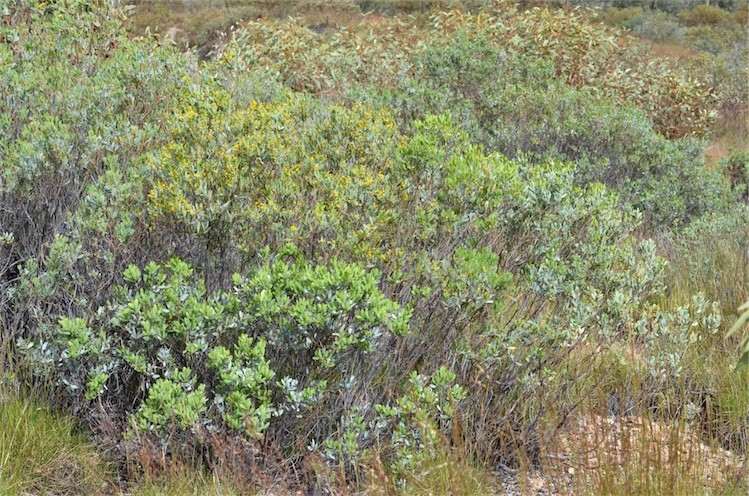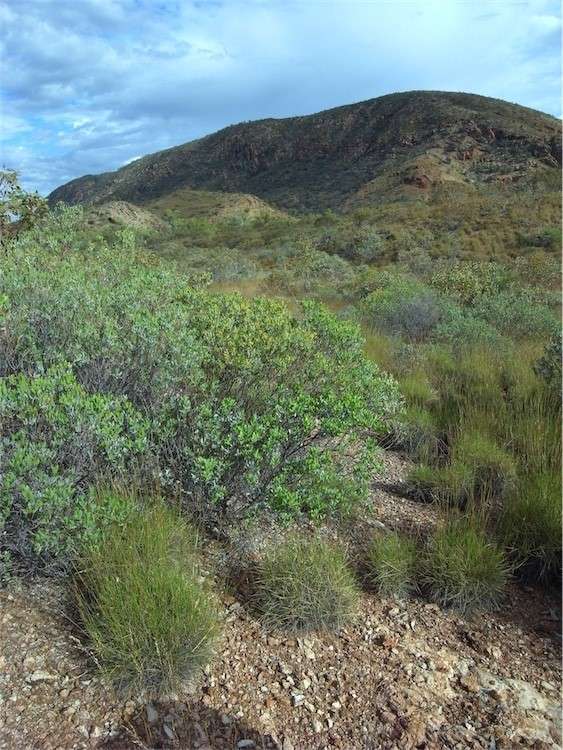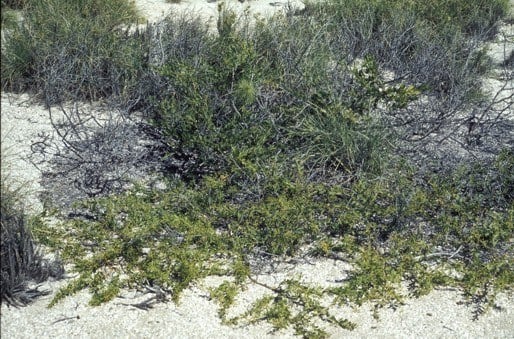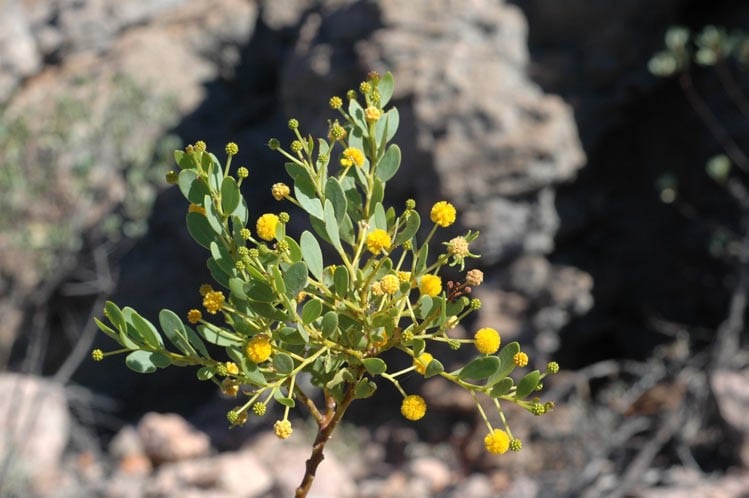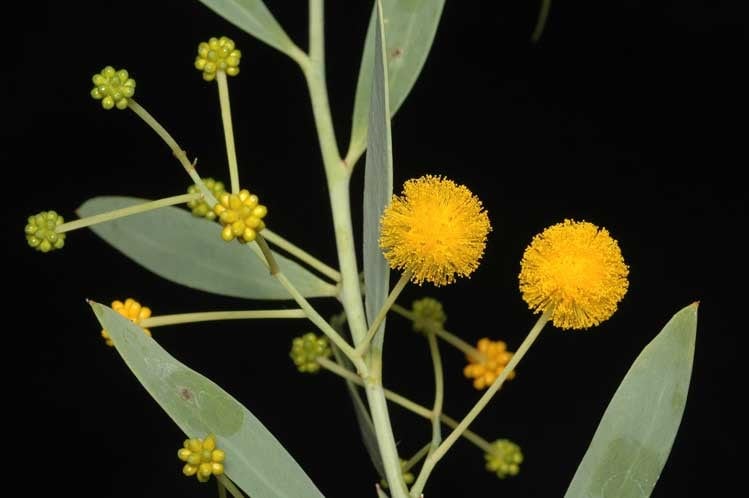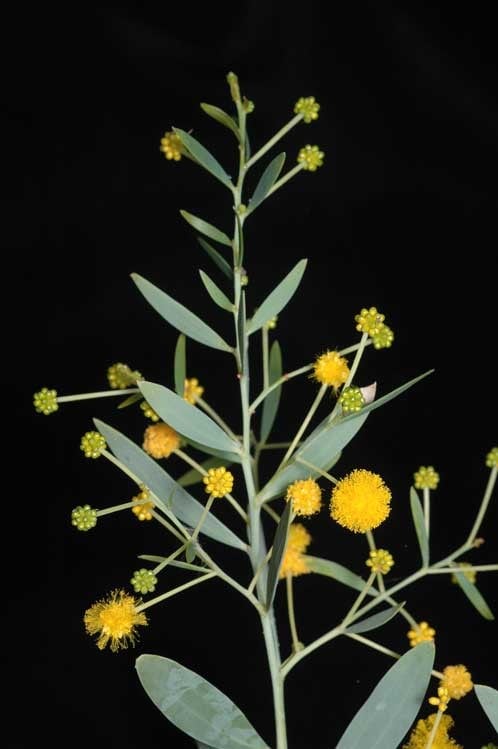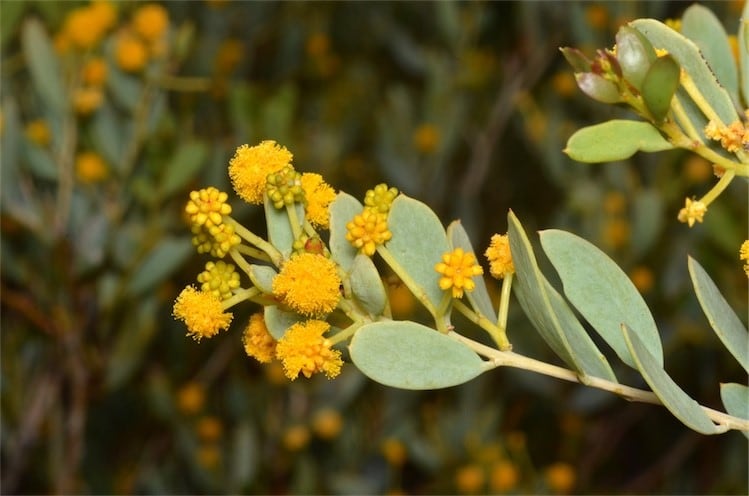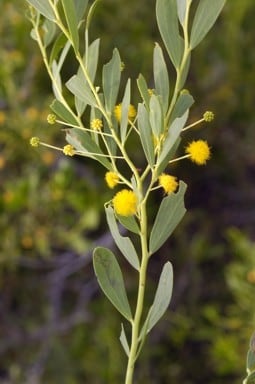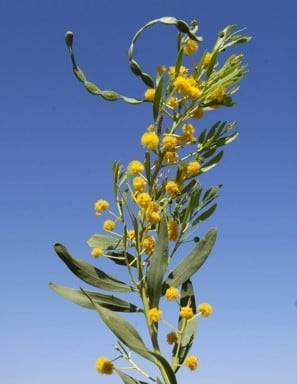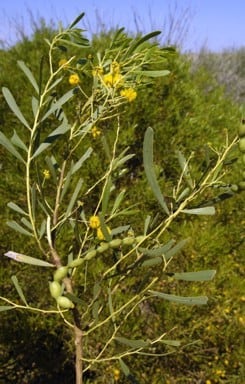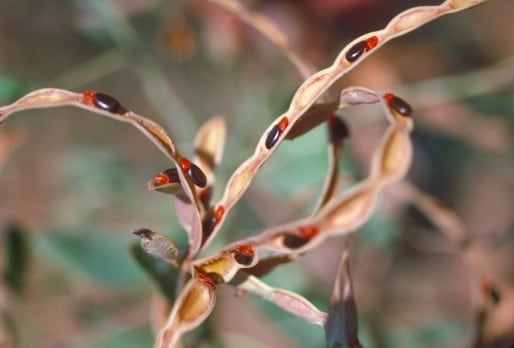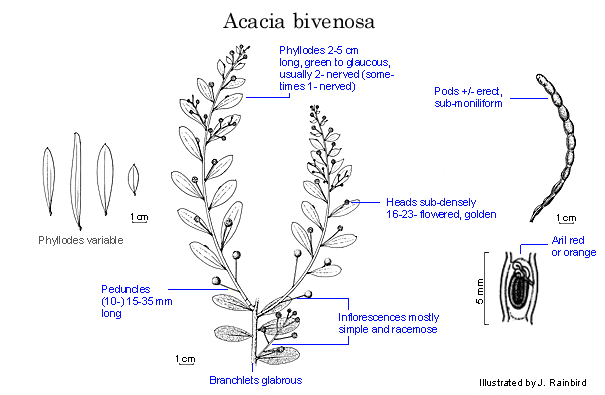Acacia bivenosa DC.
WATTLE
Acacias of Australia
Common Name
Nerved Wattle, Hill Umbrella Bush
Family
Fabaceae
Distribution
Widespread in the arid zone of W.A., N.T. and western Qld, N of 25°S, with an outlier on Dorre Is., Shark Bay, W.A.
Description
Shrub normally 1–3 m high, rarely prostrate, usually dense and glabrous. Bark smooth and light grey to medium grey. Branchlets often slightly pruinose. Phyllodes variable, usually narrowly elliptic to oblong-elliptic or obovate, usually 2–5 cm long and 6–25 mm wide with l:w = 2–5, with incurved to straight mucro, thin to subfleshy, green or glaucous, usually 2‑nerved per face; glands commonly 3, with lowermost prominent and 2–12 mm above pulvinus, and distal glands smaller with one commonly adjacent to mucro. Inflorescences 6–7-headed racemes, mostly growing out with subsequent inflorescences simple; raceme axes 2–4 cm long; peduncles (10–) 15–35 (–45) mm long; heads globular, subdense, normally
16–23-flowered, deep golden; buds bright green. Flowers 5-merous; sepals united into a ±truncate calyx. Pods ±erect and submoniliform (breaking readily at constrictions between seeds), to 8 cm long, 5–8 (–10) mm wide, firmly crustaceous to subwoody, light brown. Seeds longitudinal, oblong-elliptic, 4–6 mm long, glossy, dark brown; aril red or orange.
Phenology
Flowers May–Oct.
Habitat
Grows in a variety of soils, including coastal sand, and on rocky hillsides and gullies, in shrubland, open shrubland and open woodland, often associated with spinifex.
Specimens
W.A.: c. 10.5 km S of Yardie Ck HS towards Ningaloo, B.R.Maslin 4752 (BRI, CANB, K, PERTH); Dorre Is., A.S.Weston 10525 (PERTH). N.T.: gorge near Mt Liebig, G.Chippendale 3541 (BRI, DNA); 64.4 km W of Alexandria Stn, R.A.Perry 1565 (BRI, DNA, PERTH). Qld: c. 40 km N of Jundah, K.P.Nicolson 301 (BRI).
Notes
A.R.Chapman & B.R.Maslin, Nuytsia 8: 249-283 (1992), define and discuss the informal ‘A. bivenosa group’ which comprises the following 12 species, A. ampliceps, A. bivenosa, A. cupularis, A. didyma, A. ligulata, A. rostellifera, A. salicina, A. sclerosperma, A. startii, A. telmica, A. tysonii and A. xanthina. In the Pilbara region of W.A. A. bivenosa hybridizes with A. ampliceps (see A. ampliceps × bivenosa) and A. sclerosperma subsp. sclerosperma (see A. bivenosa × sclerosperma subsp. sclerosperma).
As discussed by A.R.Chapman & B.R.Maslin, loc. cit., A. bivenosa is a variable species, especially with respect to growth form and phyllode morphology. The phyllodes are often distinctly 2-nerved, but on plants with very narrow phyllodes and on many plants from N.T. and Qld, the second nerve can be reduced and obscure or even absent. In north-western W.A. a number of variants are recognised: plants from the Hamersley Ra. and on islands of the Dampier Archipelago have generally narrower than normal (mostly 5–12 mm wide with l:w = 3–8), narrowly elliptic to oblanceolate phyllodes (e.g. between Tom Price and the Wittenoom-Nanutarra road, B.R.Maslin 4667, PERTH); plants from Airlie Is. and Thevenard Is. have atypically long (normally 4–9 cm), 1- or 2-nerved phyllodes (e.g. V.Long 165, PERTH); at Dampier and in the Tom Price-Newman area a variant with a distinctive weeping habit is common (e.g. Burrup Penin., N of Dampier, B.R.Maslin 4740, BRI, PERTH). The sympatric occurrence of plants with green phyllodes and those with glaucous phyllodes is not unusual and has no taxonomic significance. Occasional plants from W.A., N.T. and Qld have puberulous branchlets and raceme axes.
G.Bentham’s concept of A. bivenosa included A. xanthina (Drummond 1: 283, Preiss 928) and A. didyma (Dirk Hartog Is., [A.]Cunningham [330]), fide A.R.Chapman & B.R.Maslin, Nuytsia 8: 249-283 (1992). However, A. bivenosa is readily distinguished from these two more southerly distributed species by the more elongate phyllodes of A. xanthina and wider pods of A. didyma. Often sympatric with A. startii. Closely related to and sometimes difficult to distinguish from A. ligulata (possibly due to hybridisation), particularly in south-central N.T. where they are partially sympatric.
In the Pilbara A. bivenosa is used extensively in land rehabilitation. It is generally killed by fire and regenerates from seed although under very cool burn conditions large plants may regenerate from root stock close to the base of the parent plant. Acacia bivenosa can be heavily grazed by livestock, especially at the seedling stage. Indigenous people obtained edible grubs from the roots.
FOA Reference
Data derived from Flora of Australia Volumes 11A (2001), 11B (2001) and 12 (1998), products of ABRS, ©Commonwealth of Australia
Author
Minor edits by B.R.Maslin & J.Rogers
A.R.Chapman, B.R.Maslin
This identification key and fact sheets are available as a mobile application:
URL: https://apps.lucidcentral.org/wattle/
© Copyright 2018. All rights reserved.


